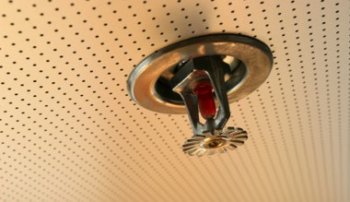Home Building Articles
Separating Fact From Fiction on Residential Fire Sprinklers
October 27, 2009

Residential fire sprinkler technology has been around for several decades, yet there
has never been a strong market demand for these potential life-saving devices. Almost
30 years ago, the idea of installing a system in the home was first developed, and
since then manufacturers have done their best to educate consumers and create new
markets. Even with all this educational material on how systems work, when given
the choice, homebuyers do not elect to have a residential fire sprinkler installed
in their home.
In several parts of this country, and in several Texas cities, local jurisdictions
have taken away the homeowners' rights to choose and have enacted ordinances that
make it mandatory to install residential sprinklers. There are several concerns
that homebuyers and builders have when it comes to residential fire sprinklers and
below are just a few of the concerns. The homebuilding industry still firmly believes
residential fire sprinklers are a significant expense that should not be forced
upon homebuyers.
- Because of changes in residential construction technology, improved building code
requirements – especially for electrical and smoke alarm systems – consumer behavior
and the concerted efforts of fire fighters, home builders and other safety advocates,
the number of fatal fires has dropped dramatically in the last 20 years. This trend
continues, and the decline is even more impressive given the significant population
growth in housing stock our nation continues to see.
- Our population grew 36 percent between 1977 and 2006, according to the U.S. Census,
while at the same time, the rate of fires per 1,000 population fell 63 percent from
14.9 in 1977 to 5.5 in 2006.
Even more dramatic is the drop in the actual death rate per million persons from
house fires. In fact, from 1979 – 2003, the rate dropped by more than 58 percent,
based on data from the Centers for Disease Control. That trend will continue as
more new housing stock is constructed and especially as the maintenance of smoke
alarms by home occupants is improved. Furthermore, the fire safety features now
required in our building codes will adequately protect the home throughout its life
without the need for fire sprinklers.
- Proponents claim that a residential sprinkler system is reliable in 96 -99 percent
of the reported structure fires, where the fire was large enough to activate the
system. But according to NFPA reports, the number of fires that occur in one-and
two-family dwellings equipped with sprinklers are so few, that they are not shown
in the studies.
- Thanks to widespread installation of residential smoke alarm systems in recent years,
Americans are safer than they've ever been. A 2006 USFA study on the presence of
working smoke alarms in residential fires from 2001 – 2004 showed that 88 percent
of the fatal fires in single-family homes occurred where there were no working smoke
alarms.
- Fire sprinkler mandates should remain an option for state and local jurisdictions.
The 2006 IRC Appendix-P adequately provides for this option and this approach was
overwhelmingly endorsed by the ICC membership where inclusion of the appendix was
approved.
- The IRC requires hard-wired, interconnected smoke alarms to be installed in all
bedrooms, outside of them and on each additional story, including basements. When
one alarm activates, all other alarms are activated as well. This effective early
warning system is the most important way to protect occupants from fire. Over 90
percent of the occupants survived fires that were reported to have occurred in homes
equipped with hard-wired, interconnected smoke alarms form 2000 to 2004.
- Unlike smoke alarms, there is no way to test sprinklers other than applying heat.
Occupants must press the test button or use products that simulate smoke to verify
that the smoke alarm is properly functioning and ready to alert occupants. Sprinkler
manufacturers must rely on test sampling to see if the sprinkler will react to the
presence of heat and activate. Defects with the sprinkler will not be known until
the sprinkler fails to activate in a fire and reports are issued later for the recall
of the defective sprinkler.
- The fire sprinkler valves must be checked periodically to verify the system is activated.
Sprinkler heads must be checked to make sure they are clear of obstacles. Homeowners
must be careful not to block them or paint over them. Also, if a backflow prevention
device is installed as can be required, an expensive annual inspection may be mandated
by the local water purveyor. Standards also specify that sprinkler pipes in the
antifreeze-type systems installed in colder climates should be emptied and then
refilled with an antifreeze solution every winter, an that monthly inspections and
tests of all the water flow devices, pumps, air pressure and water level be performed
.
- The IRC clearly states, "The purpose of this code is to provide minimum requirements
to safeguard life or limb, health and public welfare. " The IRC Commentary states
that the IRC is intended to provide reasonable minimum standards that reduce the
factors of hazardous and substandard conditions that would otherwise put the public
at risk to damaging their health, safety or welfare. Any imposition of a mandated
sprinkler requirement is excessive and is not a reasonable minimum standard for
meeting the "purpose" of the code.
Source: Texas Builder Magazine March/April 2009 edition